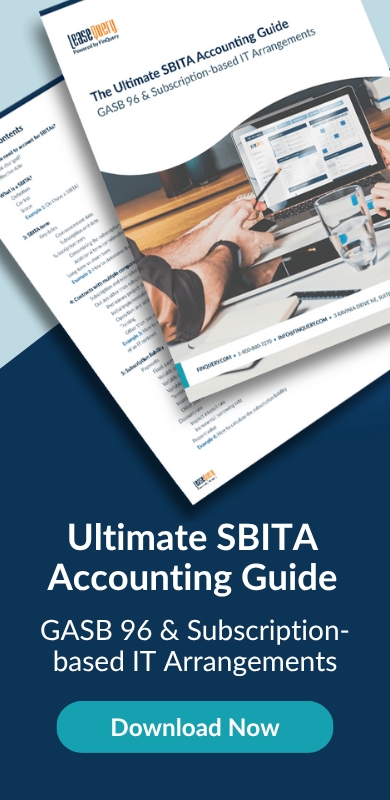What is GASB 51?
GASB Statement No. 51 Accounting and Financial Reporting for Intangible Assets (GASB 51) represents the Governmental Accounting Standards Board’s solution to accurately account for the service capacity of intangible assets, which includes internally developed computer software as well as third-party computer software that is purchased or licensed. With the increase in reliance on technology as well as the fast pace at which technology changes, many entities, including governments, have shifted away from the purchase or development of software as a standalone asset and towards subscription-based software as a service and cloud-based contracts.
GASB 51 does not govern the accounting treatment for these more recent subscription-based IT arrangements (SBITAs), and governmental agencies that have tried to analogize to GASB 51 have struggled. To better understand the difficulties, we will review what GASB 51 covers and why it has not been effective for SBITAs. Additionally, we will introduce GASB Statement No. 96 SBITAs (GASB 96), discuss why it was drafted, and preview what accounting for SBITAs will look like under GASB 96.
History of GASB 51
GASB 51 was issued in June 2007 and went into effect for periods beginning after June 15, 2009. Its focus was to improve the financial reporting for intangible assets by reducing confusion that had developed over the years due to inconsistencies in accounting and financial reporting for intangible assets. The key change to help increase clarity was to identify intangible assets as capital assets if they met the scope of GASB 51.
Many different intangible asset examples are presented directly in the standard, including but not limited to:
- Land easements
- Water rights
- Timber rights
- Patents
- Trademarks
- Computer software (specifically internally developed software and commercially available software purchased or licensed from a third party)
The standard also provides guidance on how to recognize these intangible assets for financial reporting purposes. It requires an asset meeting the definition of an intangible asset to be recognized in the statement of net position as a capital asset and amortized over its useful life. While the standard does not specifically include SBITAs, many governmental agencies have used it as a guide for accounting for subscription based arrangements. Later in this article we will cover the exact scope and reporting requirements of GASB 51, specifically compared and contrasted to GASB 96.
What is GASB 96?
GASB Statement No. 96, Subscription-Based Information Technology Arrangements (GASB 96), is effective for fiscal years beginning after June 15, 2022. The standard defines a SBITA for governmental entities. Further, it also explains how to account for SBITAs and what financial statement disclosures are required. This is especially significant considering no previous accounting guidance or disclosure requirements exist to cover SBITAs under GASB.
The standard defines a SBITA as:
“A contract that conveys control of the right to use another party’s (a SBITA vendor’s) IT software, alone or in combination with tangible capital assets (the underlying IT assets), as specified in the contract for a period of time in an exchange or exchange-like transaction.”
If a SBITA is identified, a subscription liability and a subscription asset are recognized on the statement of net position at the commencement of the SBITA’s subscription term. Due to the similarities between IT subscription arrangements and lease arrangements (i.e. both represent arrangements in which one party pays for the right to use another party’s assets for a limited period of time), the GASB largely leveraged the new GASB 87 lease accounting model when developing GASB 96.
Why is GASB 96 necessary?
Periodically GASB (the Board) develops guidance based on issues brought to their attention through research and outreach activities. Based on these activities, a large demand from stakeholders to receive guidance on how to account for SBITAs was determined. As seen above, GASB 51 merely accounted for software acquired or developed and subsequently owned by an entity rather than arrangements allowing an entity the right to temporarily use the software. Although the Board did release GASB 87 covering lease agreements, this new standard did not fully cover SBITAs either as it explicitly excludes intangible assets. Upon realization of a gap in the accounting for certain types of software agreements, the Board started to evaluate the need for a new standard.
The development of GASB 96 began with evaluating two areas of a SBITA contract:
- The use of the software
- The implementation of the software
First, the Board realized that in SBITA contracts, control of the right to use the vendor’s IT assets is granted for a limited period of time and requires a specified payment to the vendor. This is very similar to GASB 87’s definition of a lease requiring control of another entity’s nonfinancial asset for a set term in an exchange or exchange-like transaction. Secondly, implementation costs were a key issue identified during the research and outreach activities.
GASB 51 groups implementation costs into the following three categories to determine if those costs should be capitalized or expensed when incurred:
- Preliminary project stage
- Application development stage
- Post-implementation/operation stage
The necessity for GASB 96 stemmed from not having accounting guidance specifically for SBITA contracts as a result of these specific contracts not truly falling under any existing standard (i.e. GASB 51). As a result of its outreach efforts, the Board discovered inconsistencies in the accounting of SBITAs. With subscription-based arrangements becoming more popular and more frequently used, those inconsistencies and confusion would grow unless the GASB established new accounting guidance. Although the introduction of GASB 87 provided some groundwork, an update was still required to more accurately meet the needs of stakeholders trying to account for SBITA contracts.
Similarities between GASB 51 and GASB 96
The main similarity between GASB 51 and GASB 96 is computer software. Both standards provide accounting guidance for cash outlays for implementation activities for either owned/developed software or temporarily subscribed software.
The type of activity, as well as the timing of the activity, will determine what the accounting treatment of the cash outlays is. As described above, the implementation activities for SBITA’s are categorized into three stages. Under GASB 96 the three stages are:
- Preliminary project stage
- Initial implementation stage
- Operation and additional implementation stage
While the categories are similar between each statement, the type of payments included in these three stages will differ between GASB 51 and GASB 96.
What is similar between the statements, however, is the accounting treatment of the expenses in each stage, summarized below:
- Preliminary project stage – These cash outlays are expensed in the period incurred.
- Application development/initial implementation stage – Cash outlays in this stage are typically capitalized as part of the asset.
- Additional/post-implementation/operation stage – In this final stage a cost is capitalized based on whether it adds value to the asset or not. If the cash outlay increases the value of the asset, it is capitalized. If the value of the asset does not increase, the cost is expensed in the period incurred.
Differences between GASB 51 and GASB 96
As discussed above, a need existed for the Board to clarify the accounting treatment for SBITAs because GASB 51 truly did not address the growing operational technology affecting numerous organizations. GASB stakeholders were left to make their own interpretations regarding application of the guidance, resulting in inconsistencies and confusion.
The fundamental difference between these two standards is GASB 51 governs the accounting for various intangible assets, including internally-developed or acquired/licensed software that is owned, while GASB 96 establishes accounting for subscription-based IT arrangements which do not assign ownership or rights to the underlying assets to the customer on a permanent basis. This results in a different accounting approach.
The key differences in accounting treatment are shown in the chart below:
| GASB 51 | GASB 96 | |
|---|---|---|
| Application | Intangible asset | Subscription agreement |
| Term | Useful life | Limited subscription period (as established by contract) |
| Control/Access | One-time purchase or internal development resulting in ownership | Temporary control of underlying assets owned by a third party |
| Statement of Net Position | Capital asset (net with accumulated amortization) | Subscription asset and subscription liability |
| Statement of Activities | Amortization expense | Interest expense and amortization expense |
Further, as discussed above, both standards determine the capitalization of related expenses based on the nature and timing of the costs. Under GASB 51 expenses in certain categories are expected to be related to internal activities for software development such as coding, software generation, and testing. Whereas under GASB 96, expenses in each category can include services from a vendor such as implementation cost, data migration, and installation.
The accounting treatment for each type of software solution also varies based on the nature of the asset and transaction. GASB 51 is for the one-time purchase of an intangible asset. The total cost, including any applicable development costs, is capitalized and depreciated over the useful life of the asset.
GASB 96 is for subscription arrangements, which by nature are contracts requiring periodic payments, much like a lease agreement. Following this comparison, the GASB developed the accounting for SBITAs to require measuring the present value of all of the expected payments to record a subscription liability and related subscription asset. This accounting treatment takes into consideration the term a SBITA may cover.
Summary
For some time GASB 51 was the standard governmental entities sometimes used as a guide for accounting for SBITA arrangements. While GASB 51 was sufficient for software accounting for decades, the rising prevalence of subscription-based IT arrangements in recent years has outgrown the existing guidance and new accounting rules were needed. Similarities between GASB 51 and GASB 96 exist, as well as several key differences from identifying the type of software, defining the scope, valuing the asset, and reporting requirements. Through outreach and discussion with stakeholders, the Board identified a need to create a new standard for modern technology. Therefore, GASB 96 was developed to specifically address and clarify the accounting treatment of SBITA arrangements.







